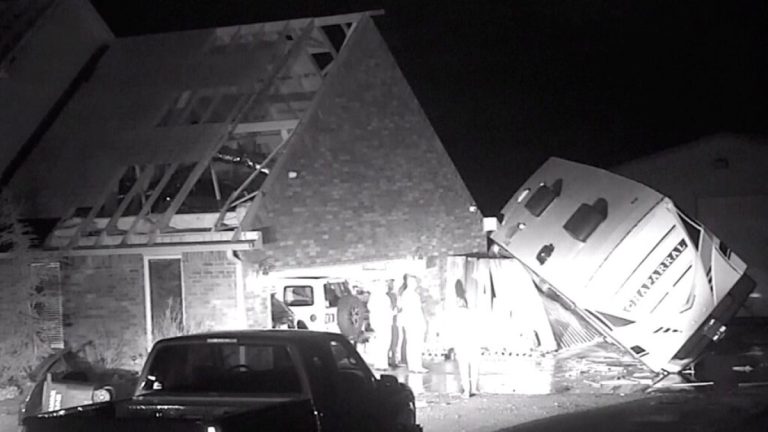Authorities are urging caution as a series of winter storms continue to bring severe weather across the United States.
A series of tornadoes have struck the central United States, leaving behind debris and injuries as winter storms continue to cause extreme weather across the country.
Nine tornadoes tore through Kansas, Oklahoma and northwest Texas on Sunday evening, flipping cars and downing trees and power lines, the National Weather Service said. The high winds caused power outages to about 12,000 homes and businesses in Oklahoma, according to the Poweroutage.us website.
“I could hear the wind coming,” Oklahoma resident Frances Tabler told KOKO TV. “Suddenly, I heard all the back windows, where the children's bedrooms were, shatter. I got up, and then the wind threw me backwards, screaming.
“It was like a blizzard in the house with all the debris flying. I was screaming for my children.”
Authorities in Norman, Oklahoma, reported at least 12 weather-related injuries, none of which were serious. In other areas of the United States, severe weather led to dangerous conditions, travel delays and damage to infrastructure.
In Michigan, a state in the Great Lakes region near Canada, ice storms have cut off power to many residents over the past five days. According to Poweroutage.us, more than 130,000 homes and businesses remained without power on Monday.
Meanwhile, in northeastern states like Connecticut, New York, Massachusetts, New Jersey and Rhode Island, heavy snow is expected to fall on Monday and Tuesday.
On the West Coast, heavy rains complicated travel and flooded roads in California.
Winter storms caused rare snowfall on parts of the state, where the sight of hills covered in white became rare. In the central coastal city of Santa Barbara, residents posted videos of people snowboarding on the usually barren hills outside the city.
While climate change has increased many forms of extreme weather, such as heat waves and floods, its impact on the intensity and frequency of winter storms is more complex, according to Tom Diliberto, a climatologist at the National Oceanic and Atmospheric Administration.
“Overall, the northern part of the United States has observed winter temperatures rising at some of the highest rates in the contiguous United States since 1896, and in the future as the planet continues to warm, you expect there to be decreasing amounts of warming,” he told Al Jazeera via email. “Snowfall is seasonal as marginal snow events turn into rain events.” “But that doesn’t mean that large individual snowstorms can’t still occur.”
According to the Storm Prediction Center, more tornadoes are still possible in states like Ohio, and the weather service forecast winds of more than 96 kilometers per hour (60 mph) in Kansas and Missouri on Monday.
The National Weather Service also issued a tornado warning for northern Indiana on Monday.
“Flying debris will pose a danger to those who find themselves homeless. Mobile homes will be damaged or destroyed,” the warning said. “Take cover now!” Move to a basement or interior room on the bottom floor of a sturdy building.



